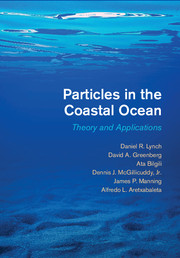Book contents
- Frontmatter
- Dedication
- Contents
- About the Authors
- Preface
- Acknowledgments
- List of Acronyms
- Definitions and Notation
- Introduction and Scope
- Part I Background
- 1 The Coastal Ocean
- 2 Drifters and Their Numerical Simulation
- 3 Probability and Statistics – A Primer
- 4 Dispersion by Random Walk
- 5 Boundary Conditions, Boundary Layers, Sources
- 6 Turbulence Closure
- Part II Elements
- Part III Applications
- Part IV Appendices
- A Series, Sums, Limits
- B Complex Numbers
- C Wiener Integrals
- D Rates and Rate Limiters
- E Diffusion Solutions
- F Covariance Matrix for Shear and Convergence
- G Summary – ARn Recursions
- H Distribution Properties for Linear Triangles
- Bibliography
- Index
- Plate Section
4 - Dispersion by Random Walk
from Part I - Background
Published online by Cambridge University Press: 05 January 2015
- Frontmatter
- Dedication
- Contents
- About the Authors
- Preface
- Acknowledgments
- List of Acronyms
- Definitions and Notation
- Introduction and Scope
- Part I Background
- 1 The Coastal Ocean
- 2 Drifters and Their Numerical Simulation
- 3 Probability and Statistics – A Primer
- 4 Dispersion by Random Walk
- 5 Boundary Conditions, Boundary Layers, Sources
- 6 Turbulence Closure
- Part II Elements
- Part III Applications
- Part IV Appendices
- A Series, Sums, Limits
- B Complex Numbers
- C Wiener Integrals
- D Rates and Rate Limiters
- E Diffusion Solutions
- F Covariance Matrix for Shear and Convergence
- G Summary – ARn Recursions
- H Distribution Properties for Linear Triangles
- Bibliography
- Index
- Plate Section
Summary
In this chapter we describe some simple random walk models. The size of the random walk is fundamentally related to the macroscale diffusion coefficient. This is assumed available as a gridded field, representing the microscale or subgrid motions. The models are classified according to the form of memory implied. These are Auto Regressive (AR) models; individual particles retain memory of their own history.
Here we develop some basic ideas about random walk through a known Eulerian environment. We assume that particle motion is a sum of resolved or “macroscale” motion (the statistical mean motion – resolved on a finite grid); and a stochastic component representing the unresolved subgrid processes (the microscale). For exposition, we assume the mean motion is zero; it can be added later, without loss of generality.
The classic literature relates the ensemble of random walks to a macroscale diffusion process; the size of the walk and the macroscale diffusion coefficient are fundamentally linked. Practical extensions are reported in Hunter et al. [202], Proehl [365], Visser [464], Riddle [382], Skellam [420], Ross and Sharples [388]; and used in the applications by Fischer et al. [153], Dimou and Adams [117], Proehl [366], to name a few. The current frontier of Lagrangian work in the coastal ocean is reported in the LAPCOD volume [186]; the summary therein [302] is particularly useful.
The literature on timeseries analysis is immediately relevant and deeper than the exposition here. Box et al. [49] is a classic work in this area. There are several more introductory texts, for example, Chatfield [79]. In particular, these include the important topics related to identifying random walk models from observed timeseries.
We begin with a simple introductory development. Next we go into the more general continuous processes and address a hierarchy of random walk models with memory.
At the macroscale level, turbulence closure provides the essential link from the macroscale diffusivity to the random walk details. In Chapter 6 the closure problem is described.
Introduction: Discrete Drunken Walk
Here we provide a brief introduction to the simplest of random walks. Readers familiar with these developments should skip this section.
Consider the 1-D drunken walk process: in any time interval, move 1, 0, or−1 units with equal probability; do this repeatedly.
- Type
- Chapter
- Information
- Particles in the Coastal OceanTheory and Applications, pp. 116 - 170Publisher: Cambridge University PressPrint publication year: 2014



